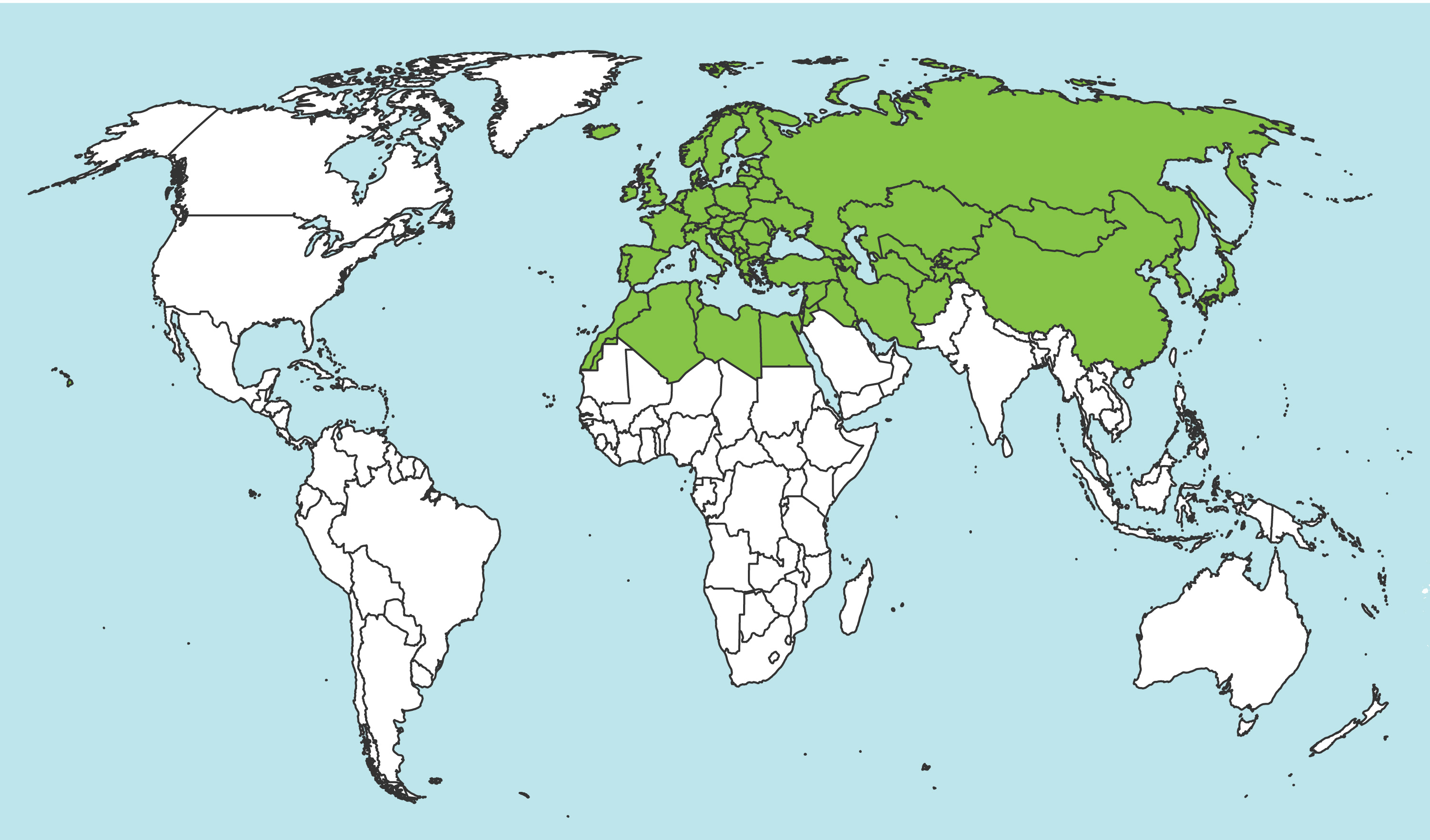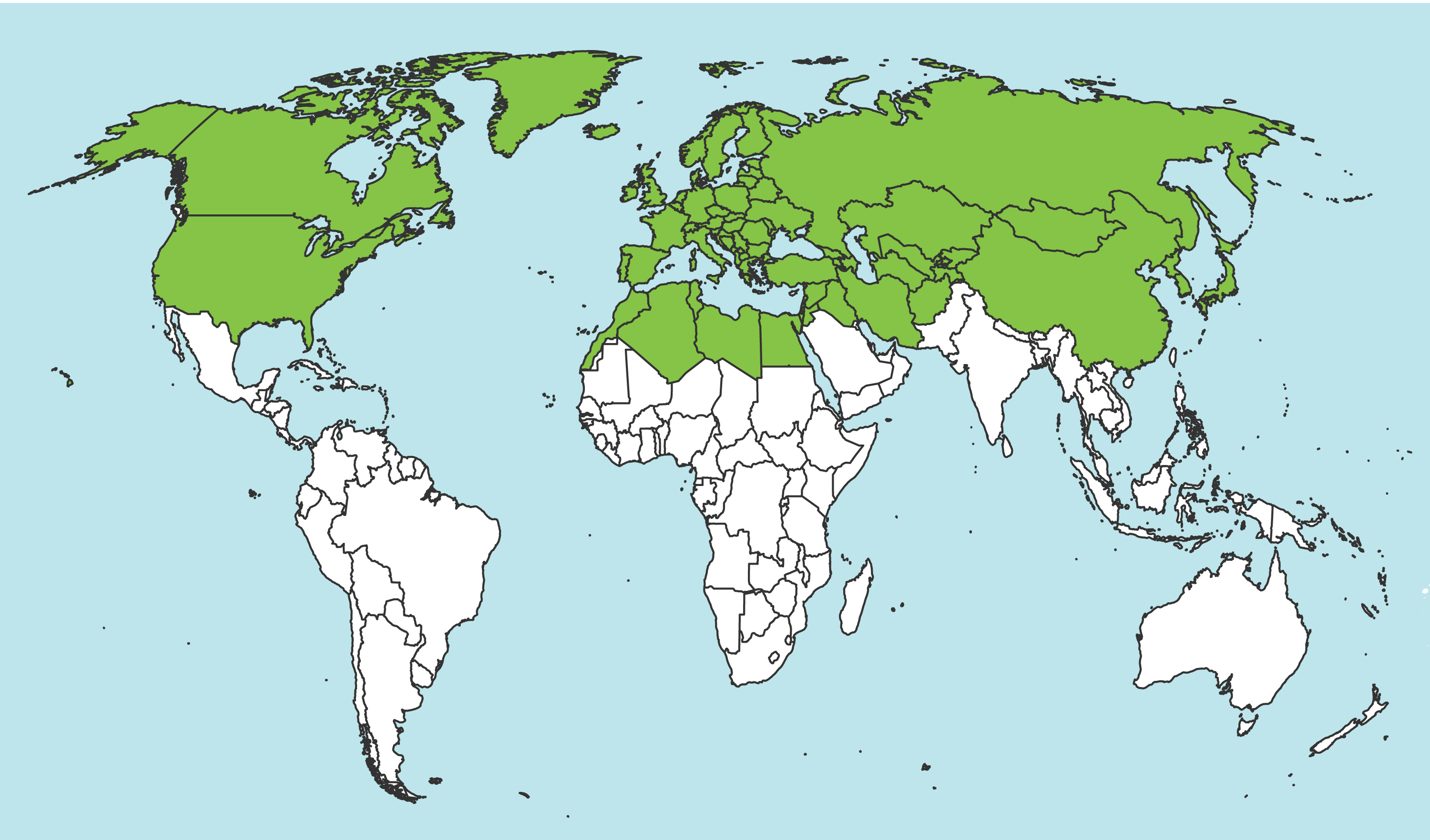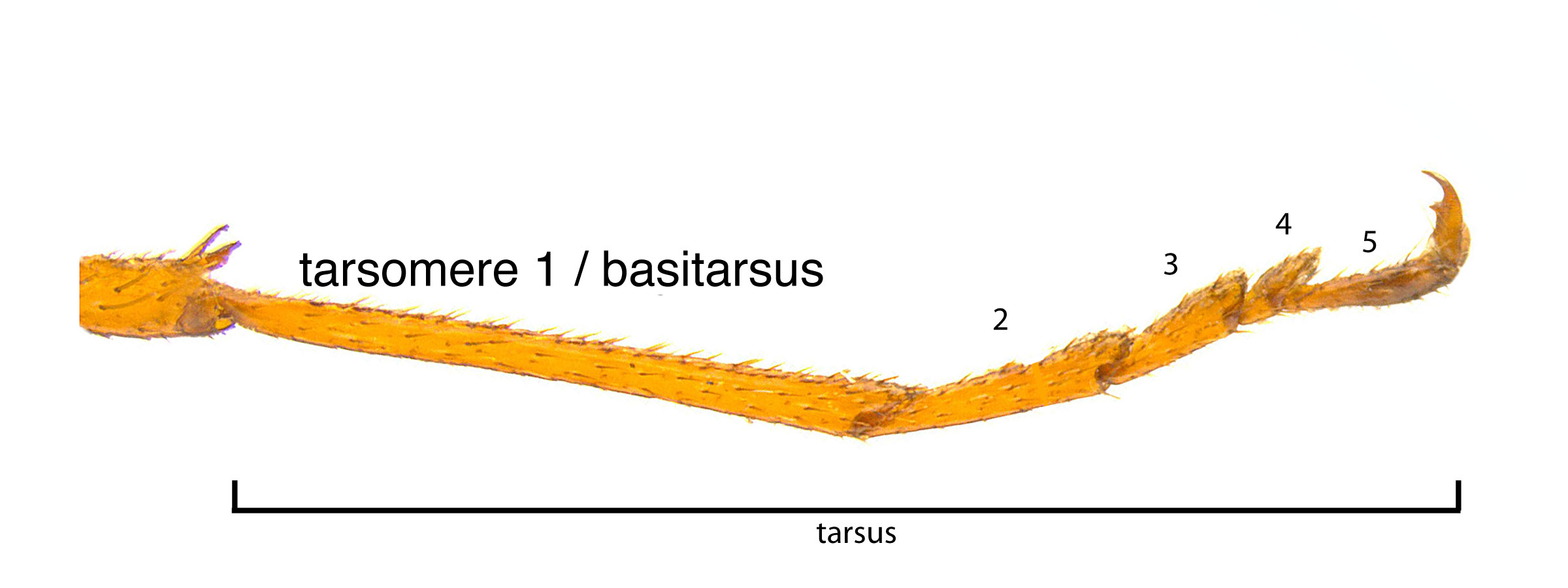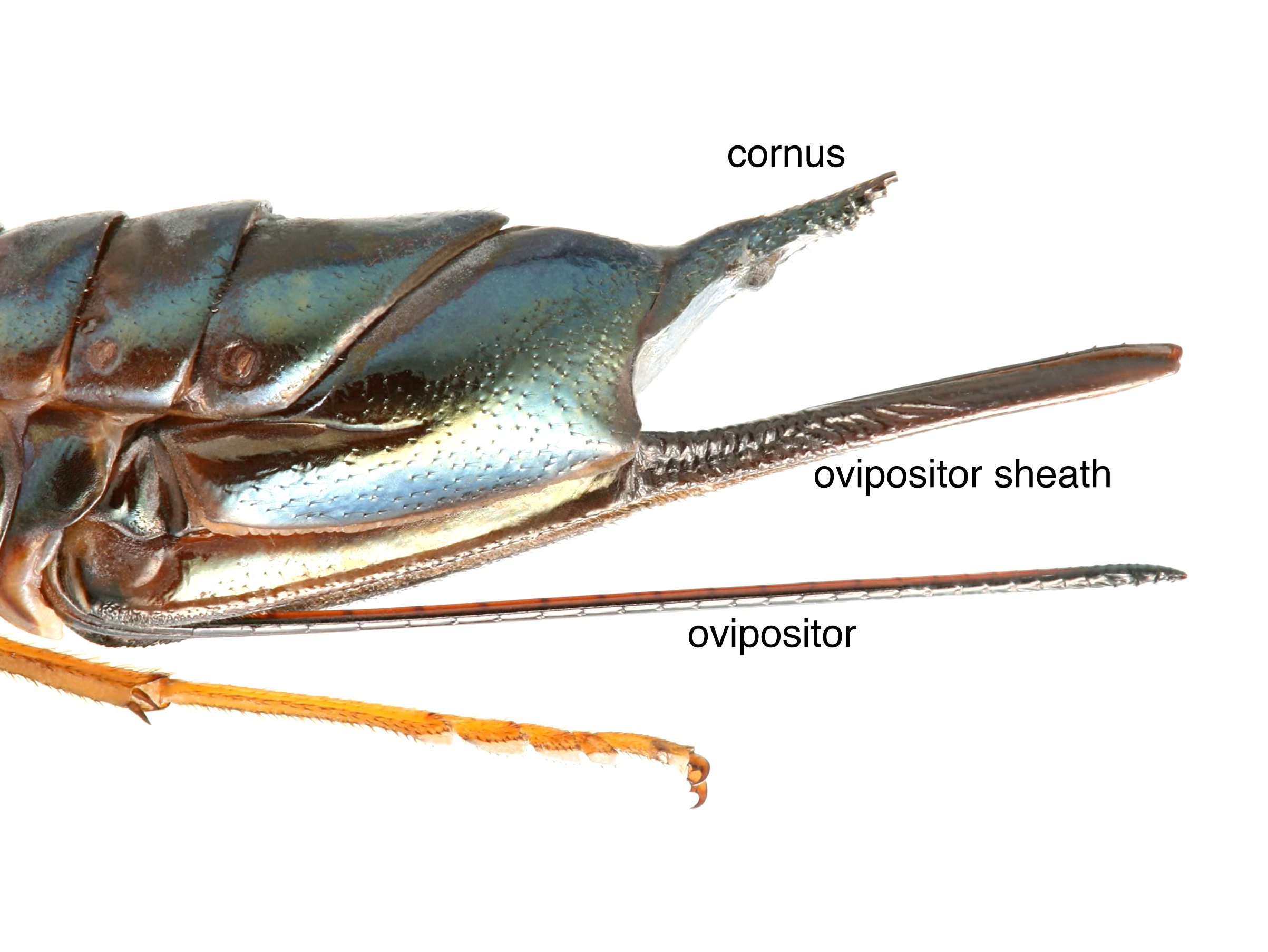Family: Siricidae
Subfamily: Siricinae
Genus: Sirex Linnaeus, 1760
Species: Sirex juvencus (Linnaeus, 1758)
Common names: steely-blue woodwasp
Sirex juvencus is a PalearcticPalearctic:
describing the region of the northern hemisphere that includes Europe, Asia south to the Himalayas and northern Africa
 species with a typical metallic blue-black coloration and red legs (Schiff et al. 2012Schiff et al. 2012:
species with a typical metallic blue-black coloration and red legs (Schiff et al. 2012Schiff et al. 2012:
Schiff NM, Goulet H, Smith DR, Boudreault C, Wilson AD, and Scheffler BE. 2012. Siricidae (Hymenoptera: Symphyta: Siricoidea) of the Western Hemisphere. Canadian Journal of Arthropod Identification 21: 1-305.).
This species historically was classified into several sub-species that have since been elevated to species (S. carinthiacus, S. imperialis, S. melanopoda), and until recently was thought to be HolarcticHolarctic:
describing the region of the Northern Hemisphere that includes both the Nearctic and Palearctic regions
 . The NearcticNearctic:
. The NearcticNearctic:
describing the region of the Northern Hemisphere that includes North America south through northern Mexico
 subspecies “S. juvencus californicus” has now been synonymized with S. cyaneus, and S. juvencus is restricted to Eurasia (Taeger et al. 2010Taeger et al. 2010:
subspecies “S. juvencus californicus” has now been synonymized with S. cyaneus, and S. juvencus is restricted to Eurasia (Taeger et al. 2010Taeger et al. 2010:
Taeger A, Blank SM, and Liston AD. 2010. World Catalog of Symphyta (Hymenoptera). Zootaxa 2580: 1-1064., Schiff et al. 2012Schiff et al. 2012:
Schiff NM, Goulet H, Smith DR, Boudreault C, Wilson AD, and Scheffler BE. 2012. Siricidae (Hymenoptera: Symphyta: Siricoidea) of the Western Hemisphere. Canadian Journal of Arthropod Identification 21: 1-305.).
See Sirex for genus-level diagnostic characteristics.
Females:
Males:
 and tarsustarsus:
and tarsustarsus: black; fore and mid tibiaetibia:
black; fore and mid tibiaetibia: and tarsitarsus:
and tarsitarsus: reddish-brown (Curtis 1829Curtis 1829:
reddish-brown (Curtis 1829Curtis 1829: with band of reddish-brown at the basebase:
with band of reddish-brown at the basebase: red (Curtis 1829Curtis 1829:
red (Curtis 1829Curtis 1829: with a yellow tint (Curtis 1829Curtis 1829:
with a yellow tint (Curtis 1829Curtis 1829:In its range, S. juvencus can be distinguished from S. torvus and S. noctilio by the pale basebase:
the beginning or most proximal area of any structure
of the antennaeantenna:
the sensory organ emerging from the front of the head, usually between the compound eyes and above the clypeus; includes the flagellum, scape and pedicel
 (Benson 1943Benson 1943:
(Benson 1943Benson 1943:
Benson RB. 1943. Studies in Siricidae, especially of Europe and southern Asia (Hymenoptera, Smphyta). Bulletin of Entomological Research 34 (1): 27-51. https://doi.org/10.1017/S0007485300023464). Previously considered to be the same species, S. cyaneus is differentiated from S. juvencus by the lack of pits on the basalbasal:
towards the base; closest to the body
part of the ovipositorovipositor:
the female organ that deposits eggs and is used to drill into plant tissue, located at the apex of the abdomen, made up of the lance and lancet
 and the color of the antennaeantenna:
and the color of the antennaeantenna:
the sensory organ emerging from the front of the head, usually between the compound eyes and above the clypeus; includes the flagellum, scape and pedicel
 (Schiff et al. 2012Schiff et al. 2012:
(Schiff et al. 2012Schiff et al. 2012:
Schiff NM, Goulet H, Smith DR, Boudreault C, Wilson AD, and Scheffler BE. 2012. Siricidae (Hymenoptera: Symphyta: Siricoidea) of the Western Hemisphere. Canadian Journal of Arthropod Identification 21: 1-305.).
none recorded
Sirex species feed on trees of Pinaceae and Cupressaceae. Sirex juvencus is recorded on Pinus sylvestris (Scots pine), Pinus strobus (eastern white pine), Pinus rigida (pitch pine), Pinus banksiana (jack pine), Pinus sibirica (Siberian stone pine), Picea jezoensis (yeddo spruce), Picea sitchensis (Sitka spruce), Picea omorika (Serbian spruce), Picea abies (Norway spruce), Picea spp., Abies alba (silver fir), Abies sibirica (Siberian fir), Abies spp., Pseudotsuga menziesii (Douglas fir), Chamaecyparis lawsoniana (Port Orford cedar), and Larix spp. (larch) (Smith 1978Smith 1978:
Smith DR. 1978. Suborder Symphyta (Xyelidae, Parachexyelidae, Parapamphiliidae, Xyelydidae, Karatavitidae, Gigasiricidae, Sepulcidae, Pseudosiricidae, Anaxyelidae, Siricidae, Xiphydriidae, Paroryssidae, Xyelotomidae, Blasticotomidae, Pergidae). Hymenopterorum Catalogus 14: 1-193., Schiff et al. 2012Schiff et al. 2012:
Schiff NM, Goulet H, Smith DR, Boudreault C, Wilson AD, and Scheffler BE. 2012. Siricidae (Hymenoptera: Symphyta: Siricoidea) of the Western Hemisphere. Canadian Journal of Arthropod Identification 21: 1-305.). Because of historic taxonomical confusion with S. juvencus, some of these records may be inaccurate.
Female Sirex harbor symbiotic basidiomycete fungus in abdominal glands called mycangia. During oviposition, the site is inoculated with the fungus, which begins to decompose the surrounding wood. LarvaeLarva:
the immature stage of holometabolous insects
 feed on the fungus, and in the process bore galleries through the wood (Schiff et al. 2012Schiff et al. 2012:
feed on the fungus, and in the process bore galleries through the wood (Schiff et al. 2012Schiff et al. 2012:
Schiff NM, Goulet H, Smith DR, Boudreault C, Wilson AD, and Scheffler BE. 2012. Siricidae (Hymenoptera: Symphyta: Siricoidea) of the Western Hemisphere. Canadian Journal of Arthropod Identification 21: 1-305.).
Larvae are creamy white and grub-like in appearance with a dark head capsule. As with adults, larvaelarva:
the immature stage of holometabolous insects
 possess a short dorsaldorsal:
possess a short dorsaldorsal:
of or on the top surface of the body or structure
horn on the posterior end of the body. The larvaelarva:
the immature stage of holometabolous insects
 bore galleries into wood, feeding until pupation and subsequent emergence. Throughout this process, the larvaelarva:
bore galleries into wood, feeding until pupation and subsequent emergence. Throughout this process, the larvaelarva:
the immature stage of holometabolous insects
 use their horn to pack the tunnel behind them with sawdust. Emergence holes are perfectly circular. The fungal symbiont is carried in specialized organs in female larvaelarva:
use their horn to pack the tunnel behind them with sawdust. Emergence holes are perfectly circular. The fungal symbiont is carried in specialized organs in female larvaelarva:
the immature stage of holometabolous insects
 that develop into the mycangia after metamorphosis (Schiff et al. 2012Schiff et al. 2012:
that develop into the mycangia after metamorphosis (Schiff et al. 2012Schiff et al. 2012:
Schiff NM, Goulet H, Smith DR, Boudreault C, Wilson AD, and Scheffler BE. 2012. Siricidae (Hymenoptera: Symphyta: Siricoidea) of the Western Hemisphere. Canadian Journal of Arthropod Identification 21: 1-305.).
Sirex juvencus in England have been observed flying in July through September (Curtis 1829Curtis 1829:
Curtis J. 1829. British Entomology; Being illustrations and descriptions of the genera of insects found in Great Britain and Ireland: containing coloured figures from nature of the most rare and beautiful species, and in many instances of the plants upon which they are found. Vol. VI. Linnaean Society.).
World: Sirex juvencus occurs widely in Europe, from the British Isles east into Russia (Smith 1978Smith 1978:
Smith DR. 1978. Suborder Symphyta (Xyelidae, Parachexyelidae, Parapamphiliidae, Xyelydidae, Karatavitidae, Gigasiricidae, Sepulcidae, Pseudosiricidae, Anaxyelidae, Siricidae, Xiphydriidae, Paroryssidae, Xyelotomidae, Blasticotomidae, Pergidae). Hymenopterorum Catalogus 14: 1-193.). It has been intercepted in North America, New Zealand, Australia, and the Philippines, but there is no evidence that it has become established (Schiff et al. 2012Schiff et al. 2012:
Schiff NM, Goulet H, Smith DR, Boudreault C, Wilson AD, and Scheffler BE. 2012. Siricidae (Hymenoptera: Symphyta: Siricoidea) of the Western Hemisphere. Canadian Journal of Arthropod Identification 21: 1-305.).
North America: This species has been intercepted at ports on the East Coast of the United States and Canada (Schiff et al. 2012Schiff et al. 2012:
Schiff NM, Goulet H, Smith DR, Boudreault C, Wilson AD, and Scheffler BE. 2012. Siricidae (Hymenoptera: Symphyta: Siricoidea) of the Western Hemisphere. Canadian Journal of Arthropod Identification 21: 1-305.).
Map data from: GBIF.org (26 June 2019) GBIF Occurrence Download Sirex juvencus
Details about data used for maps can be found here.